Contenders for State Soil

Mottled Brown Sodosol | Red Sodosol | Red Ferrosol | Grey Vertosol | Black Vertosol | Brown Dermosol | Red Dermosol | Aeric Podosol | Hypercalcic Calcarosol | Brown Chromosol | Organosol
Sodosols
 | Sodosols are common throughout Victoria. In fact, Victoria has a greater proportion of Sodosols than any other State. These soils are characterised by displaying strong texture contrast between the lighter textured surface horizons and the clayey subsoil horizons (i.e. duplex in nature). The subsoil is characteristically high in exchangeable sodium - i.e. sodic. The degree of sodicity varies - but generally these soils become increasingly sodic with depth down the soil profile. Sodic soils often require careful management to address restrictions to root and water movement, and waterlogging is a major management issue. They are also prone to land degradation - particularly gully and tunnel erosion - if land use and/or land management is not suitable. ` |
| (A) Mottled Brown Sodosol These soils have yellow to brownish yellow coloured upper subsoil horizons that are usually mottled. The subsoils are usually coarsely structured, and prismatic and/or columnar peds are common. They are generally specific to mid-range rainfall areas (i.e. 500-800 mm) and commonly occur in the Uplands regions as well as in the western volcanic plains and southern plains of Victoria. These soils mainly support dryland sheep grazing and are common in a number of areas of Victoria where gold-mining has taken place (e.g. central goldfields region). Further information is provided on this soil, including a case for why it should be considered as the State Soil for Victoria. | 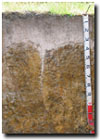 |
| (B) Red Sodosol These soils have red coloured upper subsoil horizons. The subsoils are usually coarsely structured, and prismatic and/or columnar peds are common. These soils have often previously been referred to as red-brown earths. They usually have acidic surface soil and are often alkaline at depth (often including the presence of lime). These soils occur in mid to low rainfall areas - particularly plains areas in the Wimmera, parts of Mallee, North Central, Goulburn Broken and western Port Phillip and Westernport regions. They support dryland cropping (mainly cereals) in the Wimmera; irrigated pasture, orchards and vegetable cropping on the northern plains (especially Shepparton Irrigation region), as well as high value vegetable production in the Werribee region. Further information is provided on this soil, including a case for why it should be considered as the State Soil for Victoria. | 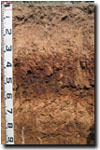 |
 | Ferrosols are non-texture contrast soils that are mainly deep, well-structured and friable. They have typically formed on older basalts, are high in free iron oxide and clay and generally strongly acid throughout. |
| (C) Red Ferrosol These soils have previously been known as 'krasnozems'. They lack strong texture contrast (i.e. they are gradational in nature), are characterised by high levels of free iron oxide (greater than 5%) and are strongly acid throughout. They are well structured and relatively deep soils and are important cropping (potato, cut flowers etc) and dairy soils in West Gippsland, where they have formed on Tertiary basalts, and are associated with rolling hills in the Warragul and Thorpdale regions. Other Ferrosols used for cropping (mainly potatoes) also occur in the Ballarat area. Other occurrences are west of Portland, Daylesford, far East Gippsland, Gembrook-Silvan, Kilmore and parts of King Valley in northeast Vic. Although this soil is very productive, it only occupies approximately 2% of the State. Further information is provided on this soil, including a case for why it should be considered as the State Soil for Victoria. | 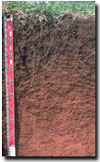 |
Vertosols | Vertosols are also known as 'cracking clay soils'. These soils are clayey throughout, display strong cracking when dry, and shrink and swell considerably during wetting and drying cycles. These soils display a range of vertic features such as lenticular peds as well as large slickensides. |
| (D) Grey Vertosol These soils occur extensively in Wimmera and in northern plains of Victoria. Small areas also occur in most other regions of Victoria - usually in lower lying areas and often associated with basalt landscapes. They are important for cereal cropping in the Wimmera region, and the self-mulching varieties (particularly in Horsham area) are highly sought. In the northern plains of Victoria where irrigation is available, these soils are used extensively for cropping (particularly tomatoes) as well as for dairy grazing. Non self-mulching Vertosols are also used for cropping but are not as highly valued - providing a less favourable soil surface condition. Further information is provided on this soil, including a case for why it should be considered as the State Soil for Victoria. | 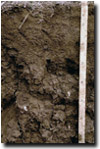 |
| (E) Black Vertosol These soils occur on basalt plain areas in the western Port Phillip as well as Corangamite regions. They also occur on the former extensive 'Koo-Wee-Rup swamp'. In the Koo-Wee-Rup region these soils have developed on swamp deposits and are highly valued for cropping (particularly potatoes and asparagus - much of which is exported to Japan). In the Koo-Wee-Rup region these soils often have a peaty layer at depth. In the western Port Phillip region, soils developed on the Merri Creek floodplain have been used to supply soil used on the MCG cricket pitch (the famous 'Merri Creek soil') due to its distinct characteristics. Further information is provided on this soil, including a case for why it should be considered as the State Soil for Victoria. | 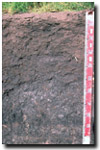 |
| (F) Brown Dermosol These soils are common in many of the hilly to mountainous country in southern Victoria (particularly in the Otway and Strzelecki ranges) and the eastern highlands. In the Otways and Strzelecki ranges they support dairy and some potato cropping. Brown Dermosols are the most widespread soil in the higher rainfall mountainous areas of northeastern Victoria - so it would be fair to say that a significant amount of the State's water resource is initially filtered by these soils. Further information is provided on this soil, including a case for why it should be considered as the State Soil for Victoria. | 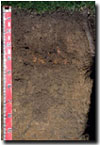 |
| (G) Red Dermosol Red Dermosols are widespread in the northeast of Victoria - particularly in higher rainfall areas where they are usually strongly acid. Here they can occur in many landscapes (from lower river terraces to mountains) and have developed on varying geology. They typically have loamy to clay loamy surfaces that grade to clay loamy to clayey structured subsoil horizons. In the northeast region, these friable and well-drained soils are often used for dairying. These soils also occur on hills and rises in the upper Campaspe and Loddon catchments, as well as in some of the upper catchments of the Goulburn-Broken and Yarra systems. So, these soils also have a role in the initial filtering of water that eventually finds its way into some of the State's key water resources. In western Victoria, Red Dermosols are often associated with stony basalt rises - but here they tend to be very shallow and stony. Further information is provided on this soil, including a case for why it should be considered as the State Soil for Victoria. | 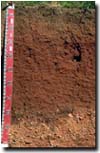 |
Podosols | These soils are mainly sandy and are characterised by a subsoil zone of variably cemented iron, aluminium and organic compounds, often referred to as 'coffee rock' that accumulates below a bleached sandy zone. Podosols are often deep, and in Queensland, for instance, can be very deep (e.g. 20-30 metres). |
| (H) Aeric Podosol These soils mainly occur in southern Victoria - mainly in the eastern Port Phillip region (particularly around Cranbourne - where the soil is referred to as 'Cranbourne Sand'), West Gippsland, dunefields in southern Gippsland, parts of the Otway ranges, in Corangamite, and in the southern Wimmera region. In many cases, these soils have formed on siliceous dunes that were deposited during drier climate regimes. In the Cranbourne area, these soils are highly prized for vegetable cropping. They can also be found in some of Melbourne region's finest golf courses and are useful for preparing bunkers! In more poorly drained situations, Aquic Podosols are likely to form. Further information is provided on this soil, including a case for why it should be considered as the State Soil for Victoria. | 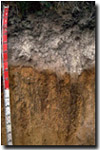 |
| (I) Hypercalcic Calcarosol These Calcarosols have subsoil horizons containing more than 20% of mainly soft carbonate (lime) as well as harder nodules or gravel. They are common in the Mallee region of Victoria and are used for dryland cropping (cereals and pulses) and also for viticulture and horticulture where irrigated (e.g. from Mildura to Swan Hill). These soils are also common in South Australia and would be a leading contender for State Soil in that state. Further information is provided on this soil, including a case for why it should be considered as the State Soil for Victoria. | 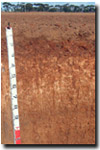 |
Chromosols | Chromosols display strong texture contrast between loamy surface (A) horizons and clayey subsoil (B) horizons. They are also characterised by having a pH (in water ) of 5.5 or greater (i.e. they are not strongly acid like Kurosols). Bleached subsurface (A2) horizons are common above the clay subsoil. Subsoils are often brightly coloured (red, brown, yellow, grey) and mottled. |
| (J) Brown Chromosol Brown Chromosols are common in the Glenelg-Hopkins region where they occur on a variety of landscapes, including the basalt plains and the Dundas Tablelands as well as some of the granite areas. Typically, these soils have subsurface accumulations of ferruginous nodules and concretions (commonly referred to as 'buckshot'). In older landscapes such as the Dundas Tablelands, the deeper subsoil may have distinct mottling (referred to evocatively as 'tiger mottles'). Other smaller occurrences of Brown Chromosols include parts of the Corangamite region, particularly adjacent to the Otways ranges; on some steep hills in Central Gippsland (mainly north of Maffra), as well as in some parts of the Goulburn Broken and North East regions (particularly lower Ovens and King catchments). Brown Chromosols are common on the Mornington Peninsula and to the east of Melbourne (e.g. Cranbourne, Coldstream areas) where they support a number of vineyards and also vegetable cropping where surface horizons are fairly deep and sandy. Further information is provided on this soil, including a case for why it should be considered as the State Soil for Victoria. | 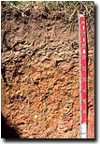 |
Organosols
| (K) Organosol Organosols are soils that are dominated by organic materials (i.e. plant-derived accumulations). Some of these soils have long been known as peats. These dark organic-rich soils are very restricted in distribution - occurring in wet drainage depressions (bogs) in some alpine and sub-alpine areas, as well as in some former swamps (e.g. in south-western Victoria). Further information is provided on this soil, including a case for why it should be considered as the State Soil for Victoria. | 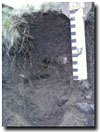 |




